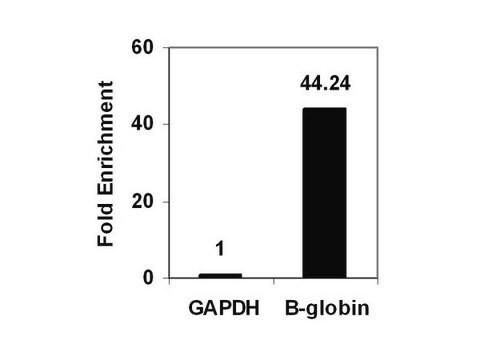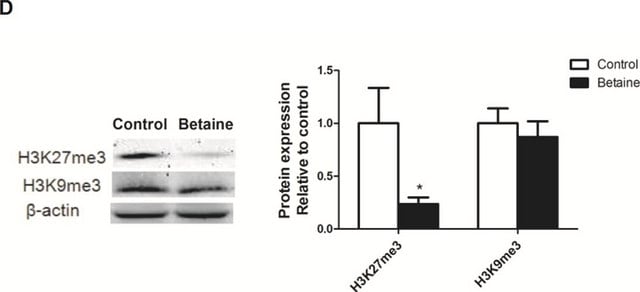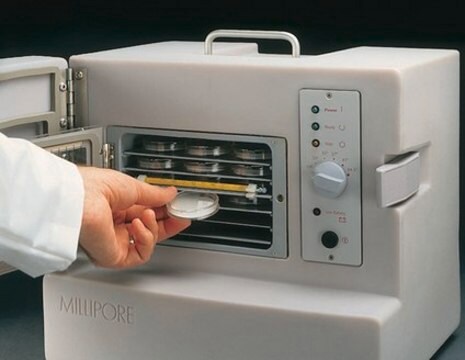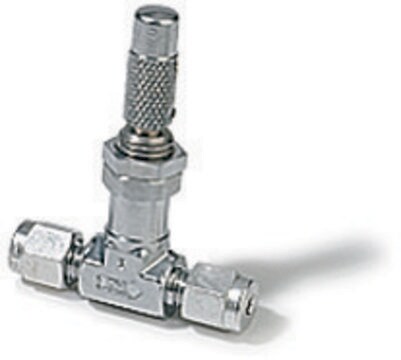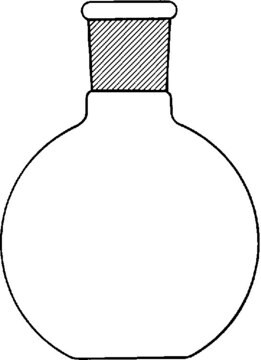17-10108
ChIPAb+ Dimethyl-Histone H3 (Lys27) - ChIP Validated Antibody and Primer Set, rabbit monoclonal
culture supernatant, from rabbit
Sinonimo/i:
H3K27me2, Histone H3 (di methyl K27), H3 histone family, member M, H3 histone, family 2, histone 2, H3c, histone cluster 2, H3c
About This Item
Prodotti consigliati
Origine biologica
rabbit
Livello qualitativo
Forma dell’anticorpo
culture supernatant
Clone
monoclonal
Reattività contro le specie
vertebrates
Produttore/marchio commerciale
ChIPAb+
Upstate®
tecniche
ChIP: suitable
cell based assay: suitable
immunoprecipitation (IP): suitable
western blot: suitable
Isotipo
IgG
N° accesso NCBI
N° accesso UniProt
Condizioni di spedizione
dry ice
Categorie correlate
Descrizione generale
The ChIPAb+ Dimethyl-Histone H3 (Lys27) set includes the Dimethyl-Histone H3 (Lys27) antibody, a negative control rabbit supernatant, and qPCR primers which amplify a 110 bp region of human β-globin promoter. The Dimethyl-Histone H3 (Lys27) and negative controls are supplied in a scalable "per ChIP" reaction size and can be used to functionally validate the precipitation of Dimethyl-Histone H3 (Lys27)-associated chromatin.
Specificità
Immunogeno
Applicazioni
Representative lot data.
Sonicated chromatin prepared from HeLa cells (1 X 10E6 cell equivalents per IP) were subjected to chromatin immunoprecipitation using either 2 µL of Negative Control Supernatant or 2 µL of Anti-dimethyl-Histone H3 (Lys27) and the Magna ChIP® A Kit (Cat. # 17-610).
Successful immunoprecipitation of dimethyl-Histone H3 (Lys27) associated DNA fragments was verified by qPCR using ChIP Primers, human β-globin as a positive locus, and GAPDH promoter primers as a negative locus (Please see figures). Data is presented as percent input of each IP sample relative to input chromatin for each amplicon and ChIP sample as indicated.
Please refer to the EZ-Magna ChIP A (Cat. # 17-408) or EZ-ChIP (Cat. # 17-371) protocol for experimental details.
Western Blot Analysis:
Representative lot data.
A 1:1000-1:5000 dilution of a previous lot detected dimethyl-Histone H3 in acid extracted proteins from HeLa cells, but did not detect unmethylated recombinant Histone H3 (Catalog # 14-494).
Recombinant Histone H3 (lane 1) and HeLa cell acid precipitate (lane 2) were resolved by electrophoresis, transferred to nitrocellulose and probed with anti-dimethyl-Histone H3 (Lys27) (1:1000 dilution).
Proteins were visualized using a goat anti-rabbit secondary antibody conjugated to HRP and a chemiluminescence detection system.
Arrow indicates dimethyl-histone H3 (~17 kDa) (Please see figures).
Peptide Inhibition Assay (PIA):
Representative lot data.
0.5-2 μM of histone H3 peptides containing dimethyl-Lys27 abolished detection of histone H3 by anti-dimethyl-Histone H3 (Lys27) (1:1000 dilution) in immunoblots of acid extracted proteins from HeLa cells.
Acid extracted proteins from HeLa cells were resolved by electrophoresis, transferred to nitrocellulose and probed with anti-dimethyl-Histone H3 (Lys27) (lane 1) or anti-dimethyl-Histone H3 (Lys27) preabsorbed with 0.5 mM of histone H3 peptides containing the following modifications:
Lane 2: dimethyl-lysine 23
Lane 3: dimethyl-lysine 27
Lane 4: dimethyl-lysine 9
A 1:1000 dilution of the primary antibody was used.
Proteins were visualized using a goat anti-rabbit secondary antibody conjugated to HRP and a chemiluminescence detection system.
Arrow indicates dimethyl-histone H3 (~17 kDa) (Please see figures).
Epigenetics & Nuclear Function
Histones
Confezionamento
Qualità
Sonicated chromatin prepared from HeLa cells (1 X 10E6 cell equivalents per IP) were subjected to chromatin immunoprecipitation using either 2 µL of Negative Control Supernatant or 2 µL of Anti-dimethyl-Histone H3 (Lys27) and the Magna ChIP® A Kit (Cat. # 17-610).
Successful immunoprecipitation of dimethyl-Histone H3 (Lys27)-associated DNA fragments was verified by qPCR using ChIP Primers, human β-globin (Please see figures).
Please refer to the EZ-Magna ChIP A (Cat. # 17-408) or EZ-ChIP (Cat. # 17-371) protocol for experimental details.
Descrizione del bersaglio
Stato fisico
Negative Control Supernatant. One vial containing 100 µL of rabbit cultured supernatant in 0.05% sodium azide. Store at -20°C.
ChIP Primers, human β-globin. One vial containing 75 μL of 5 μM of each primer specific for the human β-globin promoter. Store at -20°C.
FOR: AGG ACA GGT ACG GCT GTC ATC
REV: TTT ATG CCC AGC CCT GGC TC
Stoccaggio e stabilità
Handling Recommendations: Upon receipt, and prior to removing the cap, centrifuge the vial and gently mix the solution. Aliquot into microcentrifuge tubes and store at -20°C. Avoid repeated freeze/ thaw cycles, which may damage IgG and affect product performance.
Risultati analitici
Includes negative control rabbit supernatant and primers specific for human β-globin promoter.
Note legali
Esclusione di responsabilità
Codice della classe di stoccaggio
10 - Combustible liquids
Certificati d'analisi (COA)
Cerca il Certificati d'analisi (COA) digitando il numero di lotto/batch corrispondente. I numeri di lotto o di batch sono stampati sull'etichetta dei prodotti dopo la parola ‘Lotto’ o ‘Batch’.
Possiedi già questo prodotto?
I documenti relativi ai prodotti acquistati recentemente sono disponibili nell’Archivio dei documenti.
Il team dei nostri ricercatori vanta grande esperienza in tutte le aree della ricerca quali Life Science, scienza dei materiali, sintesi chimica, cromatografia, discipline analitiche, ecc..
Contatta l'Assistenza Tecnica.
